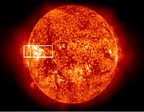

What
is VAULT?
VAULT is the Very
high Angular
resolution ULtraviolet
Telescope
designed and built by the Solar
Physics Branch of the Space
Science Division of the Naval
Research Laboratory in Washington, D.C.
| What Does VAULT Do? | |
| VAULT takes pictures of the solar chromosphere and transition region at the highest resolution (<250 km) achieved to date. VAULT takes pictures in a special band of light called the Lyman-alpha band, named after American physicist Theodore Lyman. |
|
What
is the Lyman-alpha Band?
Lyman-alpha radiation is emitted when neutral hydrogen atoms excited to their first energy level return to their ground state by giving off a burst of light at a wavelength of 1216 angstroms. An increased brightening of Lyman-alpha radiation may indicate an increase in solar radiation reaching earth.
Why
Is This Important?
Increased solar radiation is hazardous for astronauts and can damage electronics
on satellites. On earth it can damage power distribution systems, disrupt communications,
and degrade navigation systems (such as GPS).
Increased solar radiation may even warm the earth’s upper atmosphere enough to cause
it to expand into the region occupied by some satellites, slowing them down and potentially
changing their orbits.
Understanding how the sun works may allow us to predict disturbances
on the solar surface that effect earth. If we can predict these disturbances,
we can take action to protect our satellites, communications systems,
and power distribution systems.
How
Does VAULT Work?
VAULT uses a 30 cm (11.8 inch) Cassegrain
telescope followed by a zero dispersion spectroheliograph
that selects the Lyman-alpha wavelength and focuses the image onto a lumogen
coated charge coupled
device (CCD). CCDs are used in digital cameras and are 320 times more
sensitive than photographic film.
Learn
More
2003 U.S. Naval Research Laboratory
Disclaimer
